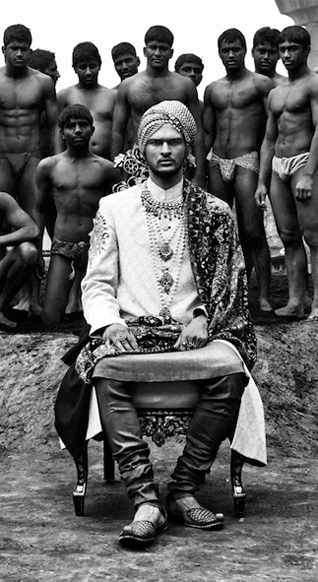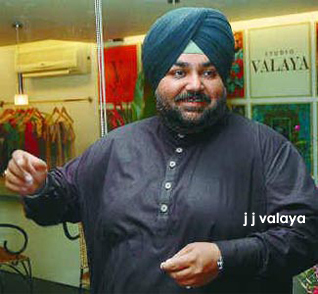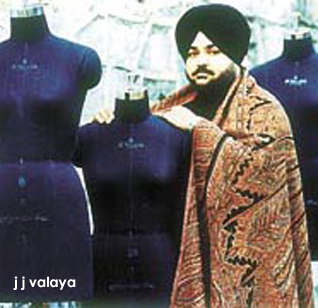Fashion
Leading Fashion Designer of India:
Sikh-Indian J.J. Valaya
ASHIMA BATISH
The turquoise bridal lehnga with intricate zari work, aesthetically used stone embellishments and the perfect silhouettes was an eye grabber.
But the cost too was an eye grabber!
So what does one do?
Check. The doubt of how many zeroes follow the digit 9 lingers.
A double-check. Five zeros, the price tag ‘humbly’ reads Rs. 900,000.
The rationale behind the five zeroes is the label attached to the creation - J.J. Valaya.
The story behind it is the story of the last 20 years, of raising the bar of creativity with every season’s collection, of becoming an industry in himself.
The subcontinent's leading couturier, Sikh-Indian J.J. Valaya happily assumes the role of a story teller.
"After all these years, I still wonder at times, whether I, as a part of first generation of fashion designers, gave birth to the Indian fashion industry or was it vice-a-versa. The speculation usually ends with the thought-look how far we have come," says Valaya, sitting comfortably on the couch placed in the opulent two-storey store of Valaya in The Gallery Mall of New Delhi.
His store is an extension of his creativity. Each collection occupies a specific area. Where creations are not placed against the wall, the framed photographs clicked by Valaya are hung, which are now a part of his coffee table book, Paradox Decoded.
J.J. Valaya studied fashion at India's National Institute of Fashion Technology ("NIFT") and interned under Rohit Khosla, whom he considers the father of Indian fashion industry. And simultaneously the process of decoding the designer continues.
"I have three important aspects of my life - my work, family and myself. Usually, people let go the third side, because the former two become too dominating. I have never let that happen".
It’s from the "myself" part that his ideas originate and get translated into his collections and photographs. Taking a nostalgic trip to 1988, he says it was in this little time he spent with himself that he mustered the courage to switch his career, from being a Chartered Accountant ("CA") to a fashion designer.
Azrak, his autumn winter collection, 2012, was worthy of the grand finale of Wills Lifestyle India Fashion Week. In the show that lasted around 25 minutes, he weaved magic. "Which transported the audience to a different realm of the Ottoman empire. To me, usual is boring. Fashion has to be larger than life."
On the same lines, even his pr`EAt line is, in fact, couture of the ready to wear, "the highest end of pr`EAt."
The storyteller now becomes a businessman.
Valaya doesn’t believe in fashion forecasts. For the couturier, what suits one’s personality defines fashion entirely. The forecast of colours, patterns, cuts, fabrics, designs for a season is nothing but what certain ‘experts’ try to ascertain and "what people blinded by glamour take as the gospel truth."
The same glamour, on the contrary, has made him more cautious. "I wouldn’t have survived 20 years in the industry if I had got addicted to glamour. I treat all the glam and glitz as a part of the game, and not the game in itself."
The same thoughts he shares with his two daughters, age 14 and 4, everyday. "They need to be cautioned because they are getting everything on the platter, also the well-established brandname."
Let the fashion enthusiasts make whatever philosophical statements; fashion for Valaya means pure business.
"Attributing fashion as passion comes much later." A bit of sentiment is attached to the completion of 20 years celebrations, but again, business makes for the prime reason. Part of the business will be the Grand Retrospective Show, which will be a form of biography of the designer on the ramp.
Also on the cards is a calendar for which personalities from the fashion industry will model. To name some, Sunil Sethi, director of FDCI, designer friends, Suneet Verma, Rohit Bal, who were also a part of the WLIFW’s final show.
It’s also the bullish market of India that keeps him focused on business.
"How can we be complacent when the whole world is exploring the Great Indian Market? Designers in the West draw inspiration from India. Now is the right time to make big bucks."
While candidly talking about his plans to multiply money, he realises that the so-called social critics will take an objection to it. The role shifts once again, from a businessman back to a story teller.
"Let me share with you the story of The Great Indian Crab. Once upon a time, a man was selling crabs of various countries in a fair. The crabs were segregated in different buckets according to the countries, for example, Portuguese, English, African, Italian, Indian.. The Indian crabs were maximum in quantity and also the cheapest. The seller explained the reason for the same - the crabs in the other buckets could climb out slowly. But the moment an Indian crab tried to escape, other crabs would pull him down. They won’t let any crab earn freedom."
The story teller makes the moral obvious. But that won’t ever make him lose his will to create dream designs, to make business. The story teller at the end of the day becomes the perfect businessman once again, as he books three orders in a span of two hours.
Any numbers of zeroes don’t matter.
What matters is his label, J.J. Valaya.
[Courtesy: Tribune]
May 2, 2012
Conversation about this article
1: Bhupinder Singh Ghai (New Delhi, India), May 01, 2012, 1:01 PM.
It's a pity he now appears in public in a pny-tail and does not wear the turban anymore. He looks more of a "fat cat". A good designer that he is, I am sure he knows he looks much more elegant when he wears the turban. Let him have a look at Waris.
2: Ravinder Singh Khalsa (U.S.A.), May 01, 2012, 5:03 PM.
"But the moment an Indian crab tried to escape, other crabs would pull him down. They won't let any crab earn freedom" - this is the story of Sikh freedom from India, a land that was never agreed to be a part of India. It was stolen much like what happened to the Native Americans in the U.S. and Aboriginals in Australia.






